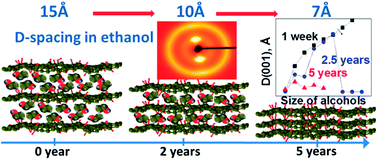Swelling of graphene oxide membranes in alcohols: effects of molecule size and air ageing†
Abstract
Swelling of Hummers graphene oxide (HGO) membranes in a set of progressively longer liquid alcohols (methanol to 1-nonanol) was studied using synchrotron radiation XRD after air ageing over prolonged periods of time. Both precursor graphite oxides and freshly prepared HGO membranes were found to swell in the whole set of nine liquid alcohols with an increase of interlayer spacing from ∼7 Å (solvent free) up to ∼26 Å (in 1-nonanol). A pronounced effect of ageing on swelling in alcohols was found for HGO membranes stored in air. The HGO membranes aged for 0.5–1.5 years show progressively slower swelling kinetics, a non-monotonic decrease of saturated swelling in some alcohols and complete disappearance of swelling for alcohol molecules larger than hexanol. Moreover, the HGO membranes stored under ambient conditions for 5 years showed a nearly complete absence of swelling in all alcohols but preserved swelling in water. In contrast, precursor graphite oxide powder showed unmodified swelling in alcohols even after 4 years of ageing. Since the swelling defines the size of permeation channels, the ageing effect is one of the important parameters which could explain the strong variation in reported filtration/separation properties of GO membranes. The time and conditions of air storage require standardization for better reproducibility of results related to performance of GO membranes in various applications. The ageing of GO membranes can be considered not only as a hindrance/degradation for certain applications, but also as a method to tune the swelling properties of HGO membranes for better selectivity in sorption of solvents and for achieving better selective permeability.



 Please wait while we load your content...
Please wait while we load your content...